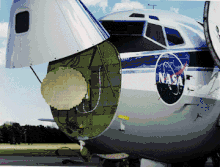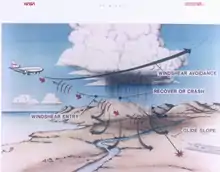ADC Airlines Flight 53
Aviation Development Company Airlines (ADC) Flight 53 was a scheduled passenger flight operated by ADC Airlines that crashed on 29 October 2006 shortly after take-off from Nnamdi Azikiwe International Airport in Abuja, Nigeria, at 11:30 am local time.[1] Immediately after takeoff from Abuja, the Boeing 737 contacted the ground, broke up and caught fire in a corn field.[1] The flight carried 100 passengers and 5 crew.[1][2] Muhammadu Maccido, the Sultan of Sokoto and spiritual leader of Nigeria's Muslims, the sultan's son, Senator Badamasi Maccido, Dr Nnennia Mgbor, the first ever female West African ENT surgeon, and Abdulrahman Shehu Shagari, son of former president Shehu Shagari, were on the passenger list.[3][4] 96 people were killed and nine people survived, among those the 3 daughters of Ibrahim Idris, governor of Kogi.[5][6]
.jpg.webp) The aircraft involved in the accident while still in operation with MetroJet at New York LaGuardia Airport in 2001 With registration N279AU | |
| Accident | |
|---|---|
| Date | 29 October 2006 |
| Summary | Wind shear, subsequent pilot error causing it to stall and crash |
| Site | near Nnamdi Azikiwe International Airport, Abuja, Nigeria 8°59′41.5″N 7°14′46.3″E |
| Aircraft | |
| Aircraft type | Boeing 737-2B7 |
| Operator | ADC Airlines |
| Registration | 5N-BFK |
| Flight origin | Margaret Ekpo International Airport, Calabar, Nigeria |
| 1st stopover | Murtala Muhammed International Airport, Lagos, Nigeria |
| Last stopover | Nnamdi Azikiwe International Airport, Abuja, Nigeria |
| Destination | Sadiq Abubakar III International Airport, Sokoto, Nigeria |
| Occupants | 105 |
| Passengers | 100 |
| Crew | 5 |
| Fatalities | 96 |
| Injuries | 9 |
| Survivors | 9 |
The plane was heading for the northern state of Sokoto. The crash sparked intense national protest to improve the nation's aviation sector. It is the direct cause for the change of the minister of aviation and the complete change to its aviation sector. This was the eleventh Nigerian airliner crash since 1995, bringing the death toll to more than 500 people.[2] The previous crash involving ADC happened on 7 November 1996; 144 people were killed when a Boeing 727 went down near Ejirin, losing control after taking evasive action to avoid a mid-air collision.[7]
President of Nigeria Olusegun Obasanjo, faced with pressure to remove Babalola Borishade, the then Minister of Aviation, transferred Borishade to another department.[8]
Flight
ADC Airlines Flight 53 departed Lagos (LOS) on a scheduled domestic flight to Sokoto (SKO) with an intermediate stop at Abuja (ABV). While on ground in Lagos, it uplifted some fuel. There was only cabin crew change. The aircraft departed Lagos on scheduled passenger service Flight 63 at 09:29 local time and landed in Abuja at 10:20. At Abuja at 11:14, the crew of the aircraft requested start-up clearance. This was given along with the prevailing weather information. At 11:21, the crew requested clearance to taxi to the holding point and a wind check; both were given. Over the following six minutes Abuja Tower gave a series of six wind reports, including a statement emphasising the gusty nature of the wind. A thunderstorm was approaching the airport and weather was worsening. At 11:26, the crew of flight 53 requested clearance for immediate takeoff, and the controller re-emphasized the deteriorating weather condition and gave latest wind check, which they acknowledged. Immediately after takeoff from runway 22, the Boeing 737 entered into a headwind -shift to-tailwind windshear, which significantly affected the aerodynamic performance of the airplane. The Pilot Flying responded to the windshear by adding a small amount of power and by pulling back on the control column causing a significant pitch attitude change. The Pilot-not-flying responded to the windshear by calling for the Pilot Flying to pull up. The airplane then entered into a full aerodynamic stall followed by a roll to the left of over 90 degrees and steep descent into the ground. The aircraft was pitched to an attitude that resulted in the temporary disruption of airflow to and momentary loss of power in both engines. The airplane broke up and caught fire in a corn field.[1]
After three unsuccessful attempts to contact the aircraft, the Tower advised the Approach Control to call Flight 53. Other aircraft on the apron (Virgin Nigeria Airlines Flight 42 and Trade Wings Flight 2401), which were on that frequency were also asked to assist in contacting the aircraft but all attempts were unsuccessful. Kano and Lagos Area Controls were requested to contact Flight 53, but there was no response from the aircraft. Abuja Flight Communication Centre was then advised to inform National Emergency Management Agency (NEMA) in Kano about the loss of contact with the aircraft. At 11:38, Flight Communication Centre called the Control Tower that someone came from a nearby village (Tungar Madaki) near the radar site and reported that a plane had crashed in their village. A search party from the airport was dispatched and they found and confirmed that the plane had crashed shortly after takeoff. 96 people were killed.[1][9]
Aircraft
The plane was manufactured in 1983. Shortly after, it was delivered to USAir as N323AU. In 1988, the aircraft changed its registration code as N279AU. In 1997, it was delivered to US Airways and in 1999 it operated by the company's MetroJet subsidiary. It was delivered to leasing company Celtic Capital and leased to Aviation Development Company (ADC) in September 2003. The plane had been checked for an inspection on 28 July 2005. It was due for another check on 27 January 2007.[10]
Investigation
The Nigerian Aircraft Investigation Bureau (AIB) started an investigation for the cause of the crash with representatives from the U.S National Transportation Safety Board (NTSB). Investigators examined the wreckage and the crash site. Based on their examination, the left wing of the aircraft first made contact with a tree branch. The aircraft impacted the ground with a high nose up position and an extreme left bank. The airplane disintegrated and a fuel spill ignited an inferno.[11]
Ninety-six of the one hundred and five persons on board were fatally injured by impact forces and post-crash fire as the majority of the fuselage section of the aircraft was destroyed. One cabin crew member, aft seated, survived along with eight other passengers as the structure in their immediate environment remained substantially intact.[11]

Analysis from black box: Just before takeoff, the crew confirmed reports of windshear, as evident from the Cockpit Voice Recorder (CVR). During takeoff, the intensity of the rain increased to heavy. The first sign of difficulty was heard on the CVR just two seconds after the first officer called "eighty knots". The captain replied with "Ah" instead of saying "checked". Four seconds later, the landing gear was retracted and the V2 callout was given by the first officer. Two seconds after the V2 callout, a windshear warning was triggered, as the aircraft experienced a rapid change in wind direction. In trying to recover, the crew pitched the nose up to between 30° and 35° as revealed by the Flight Data Recorder (FDR), thereby greatly exceeding the critical angle of attack, activating the stick-shaker (as confirmed by the cockpit voice recorder). As a result of the high pitch attitude, the airflow into the engines was disrupted causing the both engines to experience a compressor stall. Flight control inputs by the crew resulted in an aerodynamic stall, altitude loss, and subsequent ground impact. As a result of the rapid descent, the ground proximity warning system (GPWS) was indicated to have been producing terrain warnings until impact.[11]

Analysis from the pilot's reaction: Although bad weather created the situation to which the pilots reacted, their reaction was not in accordance with windshear recovery procedure. The simulator training the crew undertook at Sabena Flight Academy in Brussels, Belgium did not adequately prepare them to handle the situation in which they found themselves, even though the aircraft appeared to have enough energy to fly through the adverse weather condition. The simulator used for the training did not have the same facilities as the actual aircraft; windshear recognition and recovery was not part of the simulator training the first officer received. The captain received windshear training but it was not applicable as the simulator was not the same as the actual aircraft. Throughout the emergency period (from the first windshear warning to the ground impact) the responses from the pilot-not-flying was not in conformity with the windshear recovery procedures.[11]

Data shown from the Nigerian Meteorological Agency showed that at 09:30 and 09:45, there were scattered low top cumulus clouds. Investigators noted that significant cloud formation had occurred in the area. However, the cloud formation suddenly 'exploded' sometime between 09:45 and 11:00 UTC, and became a storm cell. These 'explosion' was called as a rapid intensification. Conditions evolved from scattered low-top cumulus to an isolated convective cell with estimated tops to above 45000 ft in just over an hour.[11]
Final report
The Nigerian AIB finally concluded that the cause of the crash was due to pilot error, as stated:
The pilot's decision to take-off in known adverse weather conditions and failure to execute the proper windshear recovery procedure resulted in operating the aircraft outside the safe flight regime, causing the aircraft to stall very close to the ground from which recovery was not possible.
Investigators also stated several contributing factors:
* The use of inappropriate equipment for windshear recovery procedure during simulator recurrency. Lack of company Standard Operating Procedures for flight operations in adverse weather conditions.
- The coordination of responsibilities and duties between the pilot flying and pilot not flying during their encounter with the adverse weather was inconsistent with Standard Operating Procedures resulting in the inadequate control of the aircraft.
Consequently, the AIB noted that the radar in the airport was off at the time of the accident. This caused a confusion and difficulty in finding the crashed plane. Had the radar not been turned off, there would be more survivors.[11]
See also
References
- Ranter, Harro. "ASN Aircraft accident Boeing 737-2B7 5N-BFK Abuja International Airport (ABV)". aviation-safety.net. Aviation Safety Network. Retrieved 24 December 2016.
- leader among those killed in Nigerian plane crash, CNN
- "Nigerian Jet Crashes, 98 Feared Dead". KYW-TV. CBS. 29 October 2006. Archived from the original on 11 March 2007.
- "Nigerian sultan among crash dead". BBC News. BBC. 29 October 2006. Archived from the original on 30 August 2014. Retrieved 24 January 2021.
- A SURVIVOR of Sunday’s ADC plane crash initially counted among the dead is alive and kicking
- Polgreen, Lydia (29 October 2006). "Jet Crashes in Nigeria, Killing 98". The New York Times. ISSN 0362-4331. Retrieved 24 January 2021.
- Ranter, Harro. "ASN Aircraft accident Boeing 727-231 5N-BBG Ejirin". aviation-safety.net. Aviation Safety Network. Retrieved 20 September 2019.
- Michaels, Daniel (1 October 2007). "Nightmare in Nigeria: How Blunders and Neglect Stoked an African Air Tragedy". The Wall Street Journal. ISSN 0099-9660. Retrieved 10 January 2009.
- "Accident Details". PlaneCrashinfo.com. PlaneCrashinfo.com. Retrieved 24 December 2016.
- "5N-BFK ADC Airlines Boeing 737-2B7(A) – cn 22891 / 988". planespotters.net. Retrieved 18 March 2016.
- "Report on the Accident to ADC Airlines, Boeing 737-2B7 Registration 5N-BFK at Tungar Madaki, Abuja on 29th October, 2006" (PDF). Accident Investigation Bureau. Archived from the original (PDF) on 30 August 2014. Retrieved 30 August 2014.
Further reading
External links
- Final report: "Report on the Accident to ADC Airlines, Boeing 737-2B7 Registration 5N-BFK at Tungar Madaki, Abuja on 29th October, 2006" (Alternate Archive). Accident Investigation Bureau.
